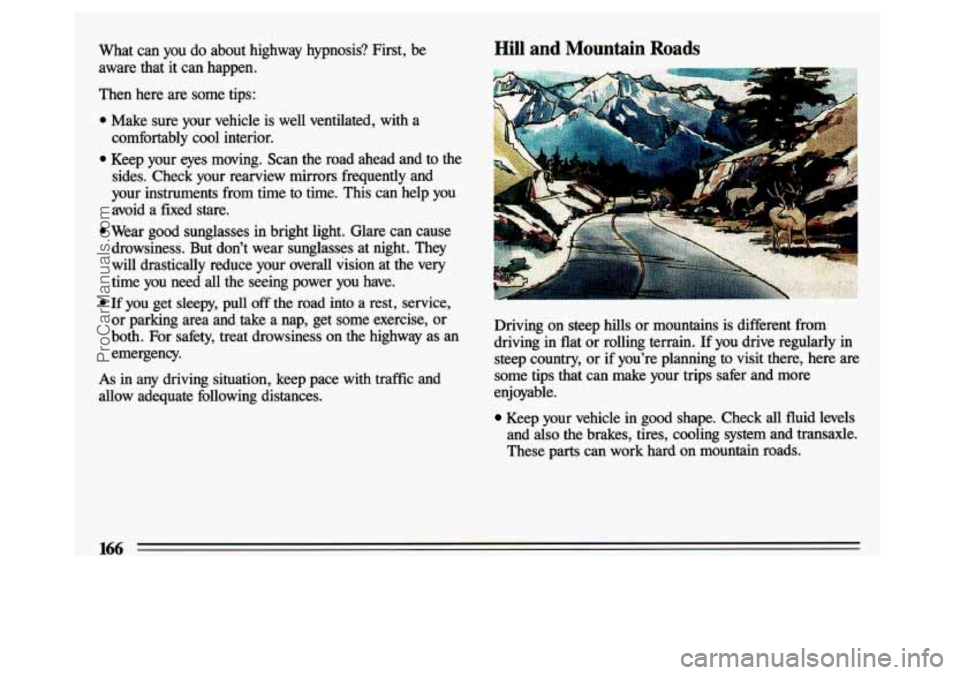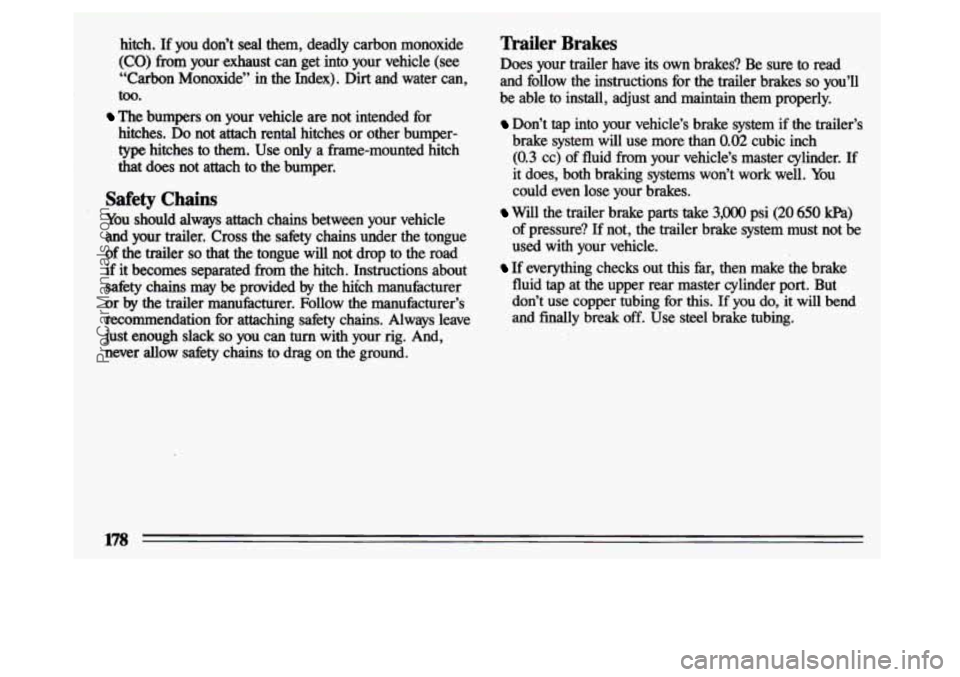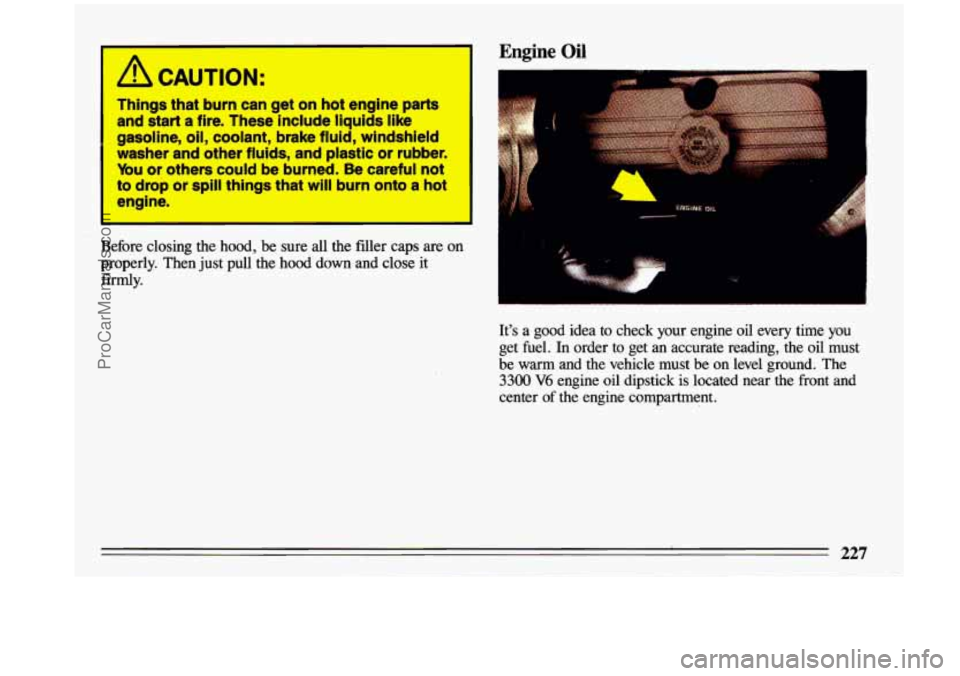1993 BUICK CENTURY brake fluid
[x] Cancel search: brake fluidPage 168 of 324

What can you do about highway hypnosis? First, be Hill and Mountain Roads
As in any driving situation, keep pace with traffic and
allow adequate following distances. Driving on steep hills
or mountains is different from
driving in flat or rolling terrain. If you drive regularly in
steep country, or if you’re planning
to visit there, here are
some tips that can make your trips safer and more
enjoyable.
Keep your vehicle in good shape. Check all fluid levels
and also the brakes, tires, cooling system and transaxle.
These parts can work hard on mountain roads.
166
ProCarManuals.com
Page 180 of 324

hitch. If you don’t seal them, deadly carbon monoxide
(CO) from your .exhaust can get into your vehicle
(see
“Carbon Monoxide” in the Index). Dirt and water can,
too.
hitches. Do not attach rental hitches or other bumper-
type hitches to them. Use only a frame-mounted hitch
that
does not attach to the bumper.
The bumpers on your vehicle are not intended for
Safety Chains
You should always attach chains between your vehicle
and your trailer. Cross the safety chains under the tongue
of the trailer so that the tongue will not drop to the road
if it becomes separated from the hitch. Instructions about
safety chains may
be provided by the hikh manufacturer
or by the trailer manufacturer. Follow the manufacturer’s
recommendation for attaching safety chains. Always leave
just enough slack
so you can turn with your rig. And,
never allow safety chains to drag on the ground.
Mer Brakes
Does your trailer have its own brakes? Be sure to read
and follow the instructions for the trailer brakes
so you’ll
be able to install, adjust and maintain them properly.
Don’t tap into your vehicle’s brake system if the trailer\
’s
brake system will use more than
0.02 cubic inch
(0.3 cc) of fluid from your vehicle’s master cylinder. If
it does, both braking systems won’t work well. You
could even lose your brakes.
Will the trailer brake parts take 3,000 psi (20 650 kPa)
of pressure? If not, the trailer brake system must not be
used with your vehicle.
If everything checks out this far, then make the brake
fluid tap at the upper rear master cylinder port.
But
don’t use copper tubing for this. If you do, it will bend
and finally break off. Use
steel brake tubing.
178
ProCarManuals.com
Page 183 of 324

Maintenance When Trailer Towing
Your vehicle will need service more often when you’re
pulling a trailer. See the Maintenance Schedule for more
on this. Things that are especially important in trailer
operation
are automatic transaxle fluid (don’t overfill),
engine oil, belt, cooling. system, and brake adjustment.
Each of these is covered in this manual, and the Index
‘will help you find them quickly.
If you’re trailering, it’s a
good idea to review these sections before you
start your trip.
Check periodically
to see that all hitch nuts and bolts are
tight.
181
ProCarManuals.com
Page 188 of 324

‘
A CAUTION:
Mu could be injured if the vehicles roll. Set
the parking brake firmly
on each vehicle. Put
an automatic transaxle
in “P” (Park) or a
manual transaxle
in “N” (Neutral). I
3. ”urn off the igni;,,n on both vehicles. lwLLL all .,hts
that aren’t needed, and radios. This will avoid sparla
and help save both batteries. And it could save your radio!
If you leave your radio OI,, it could be badl,
4. Open the hoods and locate the batteries.
I 1
A CAUTION:
An electric fan can start up even when the
engine
is not running and can Injure you. Keep
hands, clothing and tools
away from any
underhood electric fan.
I
Find the positive (+) and negative (-) terminals on
each battery.
-
/1 CAUTION:
Using a match near a battery can cause
battery gas to explode. People have been hurt
doing this, and some have been blinded.
Use a
flashlight If you need more light.
Be sure the battery has enough water. Mu
don’t need to add water to the Delco
Freedom@ battery installed
in every new GM
vehicle. But if a battery has filler caps, be sure
the
right amount of fluid is there. If it is low,
add water to take care of that first. It you don’t,
explosive gas could be present.
Battery
fluid contains acid that can burn you.
Don’t get it on you. Ifyou accidentally get it in
your
eyes or on your skin, flush the place with
water and get medical help immediately.
-
5. Check that the jumper cables don’t have loose or missing insulation.
If they do, you could get a shock.
The vehicles could be damaged, too.
186
ProCarManuals.com
Page 223 of 324

.
n
Part 6 Service and Appearance Care
. .
Here you will find information about the care of your Buick . This part begins with service and fuel information.
and then
it shows how to check important fluid and lubricant levels . There is also technical information about
your vehicle. and a section devoted to
its appearance care .
Part 6 includes:
Service ........................................................................\
..... 222
Fuel ........................................................................\
...... 223
HoodRelease ....................................................................... \
226
Engine Oil ........................................................................\
. 227
Aircleaner ........................................................................\
2.3
TransaxleFluid ..................................................................... 236
Enginecoolant ..................................................................... 239
Power Steering Fluid ................................................................. 241
Windshield Washer Fluid .............................................................. 242
Brakes ........................................................................\
.... 243
Battery ........................................................................\
.... 244
BulbReplacement ................................................................... 245
Tires ........................................................................\
...... 251
Loadingyourvehicle ................................................................. 249
Appearancecare .................................................................... 258
Vehicle Identification Number (VIN), Add-on Electrical Equipment ............................ 265
Capacities and Specifications .......................................................... -270
Fuses&CircuitBreakers .............................................................. 266
ReplacementBulbs .................................................................... 269
ProCarManuals.com
Page 229 of 324

/i CAUTION:
Things that burn can get on hot engine parts
and start
a fire. These include liquids like
gasoline, oil, coolant, brake fluid, windshield
washer and other fluids, and plastic or rubber.
You or others could be burned. Be careful not
to drop
or spill things that will burn onto a hot
engine.
Before closing the hood, be sure all the filler caps are on
properly. Then just pull the hood down and close it
firmly.
Engine Oil
I‘
I
It’s a good idea to check your engine oil every time you
get fuel. In order to get an accurate reading, the oil must
be warm and the vehicle must be on level ground. The
3300 V6 engine oil dipstick is located near the front and
center
of the engine compartment.
ProCarManuals.com
Page 238 of 324

Automatic ‘mansaxle Fluid
When to Check and Change:
A good time to check your automatic transaxle fluid level
is when the engine oil is changed. Refer to the
Maintenance Schedule to determine when to change your
fluid. See “Scheduled Maintenance Services” in the
Index.
How to Check:
Because this operation can be a little difficult, you may
choose to have
this done at a Buick dealership Service
Department.
If you do it yourself, be sure to follow all the instructions
here, or you could get a false reading on the dipstick. Wait at least
30 minutes before checking the transaxle
fluid level
if you have been driving:
When outside temperatures are above 90°F (32°C).
At high speed for quite a while.
In heavy traffic-especially in hot weather.
While pulling a trailer.
To get the right reading, the fluid should be at normal
operating temperature, which is
180°F to 200” F (82” C to
93°C).
Get the vehicle warmed up by driving about 15 miles
(24 km) when outside temperatures are above 50°F
(10°C). If it’s colder than 50” F (lO°C), you may have to
drive longer.
To check the fluid level:
Park your vehicle on a level place.
0 Place the shift lever in “P” (Park) with the parking
brake applied.
With your foot on the brake pedal, move the. shift lever
through each gear range, pausing for about three
seconds in each range. Then, position the shift lever in
“P” (Park).
Let the engine run at idle for three to five minutes.
236
ProCarManuals.com
Page 245 of 324

Brake Master Cylinder
I
Your brake master cylinder is here. It is filled with
DOT-3 brake fluid.
There are only two reasons why the brake fluid level in
your master cylinder might go down. The first is that
the
brake fluid goes down to an acceptable level during normal brake lining wear. When new linings are put in,
the fluid level goes back
up.
The other reason is that fluid is leaking out of the brake
system.
If it is, you should have your brake system fixed,
since a leak means that sooner
or later your brakes won’t
work well, or won’t work at all.
So, it isn’t a good idea to “top off’ your brake fluid.
Adding brake fluid won’t correct a leak. If you add fluid
when your linings are worn, then you’ll have too much
fluid when you get new brake linings.
You should add (01
remove) brake fluid, as necessary, only when work is
done on the brake hydraulic system.
A CAUTION:
If you have too much brake fluid, it can spill on
the engine. The fluid
will burn if the engine is
hot enough. Mu or others could be burned,
and your vehicle could
be damaged. Add
brake fluid only when work is done on the
brake hydraulic system.
When your brake fluid falls to a low level, your brake
warning light will come on. See “Brake System Warning
Light” in the Index.
What to Add:
When you do need brake fluid, use only DOT-3 brake
fluid-such as Delco Supreme
ll@ (GM Part No.
1052535). Use new brake fluid from a sealed container
only.
ProCarManuals.com